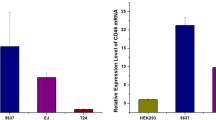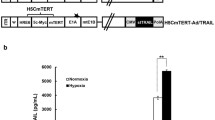Abstract
To construct an adenovirus carrying SEA gene and regulated by telomerase reverse transcriptase (hTERT) and hypoxia-inducible factor (HIF) promoters and investigate its anti-tumor function in vitro, as well as its role in lymphocyte production. hTERT and HIF genes were cloned into adenovirus E1A and E1B shuttle plasmids. The control vector for SEA gene expression is under the regulation of CMV and SV40 promoters. Double regulation was obtained through homologous recombination. The positive clones of replicable adenovirus H2-SEA-Ad were selected by plaque assay. The adenovirus was purified, titrated, and DNA was verified by PCR. The obtained virus was used to infect EJ bladder tumor cells and the SEA Mrna, and protein expression was measured by RT-PCR, western blot, and immunofluorescence microscopy, respectively. Co-culture of lymphocytes and tumor cells was observed dynamically under microscope. The construction of shuttle plasmid p315-CSS-SEA was confirmed by PCR and DNA sequencing. Insertion of superantigen SEA gene in adenovirus (H2-SEA-Ad.SEA) was obtained by homologous recombination. In lymphocytes and tumor cell co-culture, the number of viable tumor cells in test groups was significantly lower than that in control group after 12, 24, and 48 h of treatment. Production of interleukin-2, interleukin-4, and tumor necrosis factor were higher in test groups than in control group. Expression of SEA gene in bladder tumor cells by adenoviral vector caused reduced tumor cell proliferation, as well as stimulation of inflammatory cytokine productions in co-cultures with lymphocytes.











Similar content being viewed by others
References
Song, Julie H., Francis, Isaac R., Platt, Joel F., Cohan, Richard H., Mohsin, Jamil, Kielb, Stephanie J., et al. (2001). Bladder tumor detection at virtual cystoscopy. Journal of Radiology, 218, 95.
Sherwood, Benedict T., Richardson, Donna, Colquhoun, Alexandra J., Jones, George D., O’Byrne, Kenneth J., Kockelbergh, Roger C., et al. (2004). Expression of hypoxia-inducible carbonic anhydrase IX (CAIX) and outcome after radiotherapy for muscle-invasive bladder cancer. AACR Meeting Abstracts, 2004, 1035.
Kaczmarek, P., Blaszczyk, J., Kowalski, J., & Niemirowicz, J. (2002). Evaluation of side effects after intrabladder instillations of preparations in patients with superficial bladder carcinoma. Polski merkuriusz lekarski, 12, 39–42.
Madisch, I., Harste, G., Pommer, H., & Heim, A. (2005). Phylogenetic analysis of the main neutralization and hemagglutination determinants of all human adenovirus prototypes as a basis for molecular classification and taxonomy. Journal of Virology, 79, 15265–15276.
Segerman, A., Atkinson, J. P., Marttila, M., Dennerquist, V., Wadell, G., & Arnberg, N. (2003). Adenovirus type 11 uses CD46 as a cellular receptor. Journal of Virology, 77, 9183–9191.
Guo, Z. S., Thorne, S. H., & Bartlett, D. L. (2008). Oncolytic virotherapy: molecular targets in tumor-selective replication and carrier cell-mediated delivery of oncolytic viruses. Biochimica et Biophysica Acta (BBA), 1785, 217–231.
Lazennec, G., & Christian Jorgensen, C. (2008). Concise review: adult multipotent stromal cells and cancer: risk or benefit? Stem Cells, 26, 1387–1394.
Roth, J. A. (2006). Adenovirus p53 gene therapy. Expert Opinion on Biological Therapy, 6, 552–561.
Kircheis, R., & Wagner, E. (2003). Technology evaluation: TNFerade, GenVec. Current Opinion in Molecular Therapeutics, 5, 437–447.
Cheong, S. C., Wang, Y., & Meng, J.-H. (2008). E1A-expressing adenoviral E3B mutants act synergistically with chemotherapeutics in immunocompetent tumor models. Cancer Gene Therapy, 15, 40–50.
Frisch, S. M. (1996). Reversal of malignancy by the adenovirus E1A gene. Mutation Research, 350, 261–266.
Frisch, S. M., & Dolter, K. E. (1995). Adenovirus E1a-mediated tumor suppression by a c-erbB-2/neu-independent mechanism. Cancer Research, 55, 5551–5555.
Ueno, N. T., Yu, D. H., & Hung, M. C. (1997). Chemo sensitization of HER-2/neu2 over expressing human breast cancer cells to paclitaxel by adenovirus type 5 E1A. Oncogene, 15, 953–960.
Baird, S. K., & Aerts, J. L. (2008). E1A-expressing adenoviral E3B mutants act synergistically with chemotherapeutics in immunocompetent tumor models. Oncogene, 27, 3081–3090.
Raki, M., Särkioja, M., Desmond, R. A., Chen, D. T., Bützow, R., Hemminki, A., et al. (2008). Oncolytic adenovirus Ad5/3-Δ24 and chemotherapy for treatment of orthotopic ovarian cancer. Gynecologic Oncology, 108, 166–172.
Zheng, X., Rao, X. M., Gomez-Gutierrez, J. G., Hao, H., McMasters, K. M., & Zhou, H. S. (2008). Adenovirus E1B55K region is required to enhance cyclin E expression for efficient viral DNA replication. Journal of Virology, 82, 3415–3427.
Steegenga, W. T., Riteco, N., Jochemsen, A. G., Fallaux, F. J., & Bos, J. L. (1998). The large E1B protein together with the E4orf6 protein target p53 for active degradation in adenovirus infected cells. Oncogene, 16, 349–357.
Morley, S., MacDonald, G., Kirn, D., Kaye, S., Brown, R., & Soutar, D. (2004). The dl1520 virus is found preferentially in tumor tissue after direct intratumoral injection in oral carcinoma. Clinical Cancer Research, 10, 4357–4362.
Hu, F., Hu, X. H., & Yu, P. (2006). Abscopal effect on metastatic tumor induced by oncolytic virus of H101 combining with local heating. AiZheng, 25, 919–924.
Toyoda, E., Doi, R., Kami, K., Mori, T., Ito, D., Koizumi, M., et al. (2008). Midkine promoter-based conditionally replicative adenovirus therapy for midkine-expressing human pancreatic cancer. Journal of Experimental & Clinical Cancer Research, 21, 27–30.
Zhu, H., Ling, W., Hu, B., Su, Y., Qiu, S., Xiao, W., et al. (2006). Adenovirus E1A reverses the resistance of normal primary human lung fibroblast cells to TRAIL through DR5 upregulation and caspase 8-dependent pathway. Cancer Biology & Therapy, 5, 180–188.
Hu, B., Zhu, H., Qiu, S., Su, Y., Ling, W., Xiao, W., et al. (2004). Enhanced TRAIL sensitivity by E1A expression in human cancer and normal cell lines: inhibition by adenovirus E1B19K and E3 proteins. Biochemical and Biophysical Research Communications, 325, 1153–1162.
Evans, C. H., Gouze, E., Gouze, J. N., Robbins, P. D., & Ghivizzani, S. C. (2006). Gene therapeutic approaches-transfer in vivo. Advanced Drug Delivery Reviews, 58, 243–258.
Nikolaev, A. Y., Li, M., Puskas, N., Qin, J., & Gu, W. (2003). Parc: a cytoplasmic anchor for p53. Cell, 112, 29–40.
Wilmott, R. W., Amin, R. S., Perez, C. R., Wert, S. E., Keller, G., Boivin, G. P., et al. (1996). Safety of adenovirus 2 mediated transfer of the human cystic fibrosis transmembrane conductance regulator cDNA to the lungs of nonhuman primates. Human Gene Therapy, 7, 301–318.
Author information
Authors and Affiliations
Corresponding author
Additional information
X.Xuan is the co-first author. Xujun Xuan and Jianpeng Hu had equal contribution to this study.
Rights and permissions
About this article
Cite this article
Hu, J., Xuan, X., Han, C. et al. Anti-tumor Function of Double-promoter Regulated Adenovirus Carrying SEA Gene, in the Treatment of Bladder Cancer. Cell Biochem Biophys 62, 353–359 (2012). https://doi.org/10.1007/s12013-011-9289-y
Published:
Issue Date:
DOI: https://doi.org/10.1007/s12013-011-9289-y




